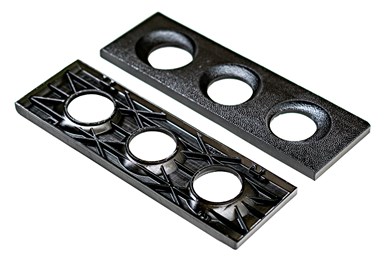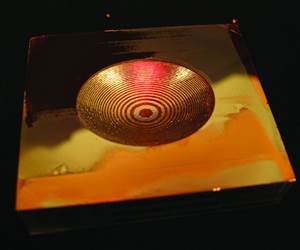3D Systems Materials Expand Capabilities of SLA, Figure 4 Platforms
3D Systems’ latest high-performance materials can enable efficient production of end-use parts in industries such as automotive, aerospace, semiconductor and consumer goods.
Parts produced with Accura AMX Tough FR V0 Black are flame-retardant and pass UL 94 V0 test standards. This high performance, fast-printing material is able to produce production-ready parts in high quantities or at large scale. Photo Credit: 3D Systems
3D Systems has developed new materials to enhance its stereolithography (SLA) and Figure 4 portfolios – Accura AMX Tough FR V0 Black, Figure 4 Tough FR V0 Black, and Figure 4 JCAST-GRN 20. These high-performance materials can enable efficient production of end-use parts in industries such as automotive, aerospace, semiconductor and consumer goods.
Flame-Retardant SLA Material for Large-format Parts
3D Systems is continuing the evolution of its SLA materials with the introduction of Accura AMX Tough FR V0 Black. The company’s materials scientists developed a chemistry based on its Figure 4 materials that enabled the industry’s first flame-retardant material for SLA. As a result, the material is also available as Figure 4 Tough FR V0 Black for use with 3D Systems’ Figure 4 platform, enabling customers to scale part sizes and leverage the system advantages provided by each platform.
Accura AMX Tough FR V0 Black delivers enhanced part quality and resolution for SLA that was previously only achievable with selective laser sintering (SLS) and fused deposition modeling (FDM) technologies. This flame-retardant material achieves UL 94 V0 rating and offers a combination of flexural modulus and unmatched elongation at break of nearly 35%. These properties combine with long-term stability to make the new Tough FR V0 Black material well suited for applications such as printed circuit board covers, semiconductor equipment, electrical housing, covers, hangers, brackets and flame-retardant parts for trains and buses.
Jewelry Casting Material Improves Direct Casting Workflow
3D Systems’ Figure 4 Jewelry is an affordable solution optimized for jewelry design and manufacturing workflows. The company’s Figure 4 JCAST-GRN 20 is its latest jewelry casting material, which is optimized for clean and easy burnout of finely detailed, high-resolution, accurate, repeatable jewelry patterns for direct casting. This new offering complements 3D Systems’ multijet printing (MJP) offerings for jewelry casting. The material’s enhanced properties make it well suited for the production of master patterns for gypsum investment casting of all types of jewelry, and suitable for a range of precious metals. The fully integrated workflow includes jewelry-specific build styles in 3D Sprint which provides design flexibility. The integrated workflow can also eliminate the need for postcuring, enabling a fast turnaround of casting patterns.
“Materials are at the core of our additive manufacturing solutions,” says Marty Johnson, vice president, product and technical fellow, 3D Systems. “It’s imperative that we offer our customers the most advanced materials in a fully integrated system to address their unique application needs. Their challenges fuel our innovation. With the introduction of these novel SLA and Figure 4 materials, we are able to deliver additional capabilities to our customers that will facilitate operation and application flexibility and accelerate their innovation.”
- Read about how 3D Systems’ Accura AMX resin withstands harsh thermal environments. The resin material is well suited for the testing of high-temperature components in applications such as HVAC, consumer appliances, motor enclosures, fixtures, mounts, stators, molding/tooling and more.
- Learn about 3D Systems verifying the performance of NASA’s GRX-810 super alloy. This oxide dispersion-strengthened alloy, developed by NASA, demonstrates exceptional mechanical properties and resistance to extreme temperatures, making it well suited for future use in critical components such as rocket engines, turbine blades and exhaust nozzle components.
Related Content
10 Important Developments in Additive Manufacturing Seen at Formnext 2022 (Includes Video)
The leading trade show dedicated to the advance of industrial 3D printing returned to the scale and energy not seen since before the pandemic. More ceramics, fewer supports structures and finding opportunities in wavelengths — these are just some of the AM advances notable at the show this year.
Read More3D Printed Cold Plate for an Electric Race Car: The Cool Parts Show #51
An unconventional lattice design and biomimicry are key to the performance of this fluid-cooled heat exchanger for a battery-powered race car.
Read MoreAM 101: What is Ultrasonic Additive Manufacturing?
Going from additive to subtractive can be simple with Ultrasonic Additive Manufacturing (UAM). What is it and how does it work? Learn the basics in this 101 post.
Read MoreWhat is Powder Bed Fusion 3D Printing?
Whether in metal or polymer, with a laser or an electron beam, powder bed fusion (PBF) is one of the most widely used 3D printing techniques.
Read MoreRead Next
4 Ways the Education and Training Challenge Is Different for Additive Manufacturing
The advance of additive manufacturing means we need more professionals educated in AM technology.
Read More3D Printing Brings Sustainability, Accessibility to Glass Manufacturing
Australian startup Maple Glass Printing has developed a process for extruding glass into artwork, lab implements and architectural elements. Along the way, the company has also found more efficient ways of recycling this material.
Read MoreHybrid Additive Manufacturing Machine Tools Continue to Make Gains (Includes Video)
The hybrid machine tool is an idea that continues to advance. Two important developments of recent years expand the possibilities for this platform.
Read More








.png;maxWidth=300;quality=90)












